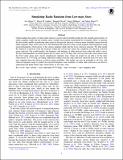Files in this item
Simulating radio emission from low-mass stars
Item metadata
| dc.contributor.author | Llama, Joe | |
| dc.contributor.author | Jardine, Moira M. | |
| dc.contributor.author | Wood, Kenneth | |
| dc.contributor.author | Hallinan, Gregg | |
| dc.contributor.author | Morin, Julien | |
| dc.date.accessioned | 2018-02-26T13:30:07Z | |
| dc.date.available | 2018-02-26T13:30:07Z | |
| dc.date.issued | 2018-02-06 | |
| dc.identifier | 252394815 | |
| dc.identifier | a4de99fd-e14a-4c26-ba04-e9f1c51af78c | |
| dc.identifier | 000424362100001 | |
| dc.identifier | 85042457208 | |
| dc.identifier | 000424362100001 | |
| dc.identifier.citation | Llama , J , Jardine , M M , Wood , K , Hallinan , G & Morin , J 2018 , ' Simulating radio emission from low-mass stars ' , Astrophysical Journal , vol. 854 , no. 1 , 7 . https://doi.org/10.3847/1538-4357/aaa59f | en |
| dc.identifier.issn | 0004-637X | |
| dc.identifier.other | ORCID: /0000-0002-1466-5236/work/57821855 | |
| dc.identifier.uri | https://hdl.handle.net/10023/12785 | |
| dc.description | M.M.J. acknowledges support from STFC grant ST/M001296/1. | en |
| dc.description.abstract | Understanding the origins of stellar radio emission can provide invaluable insight into the strength and geometry of stellar magnetic fields and the resultant space weather environment experienced by exoplanets. Here, we present the first model capable of predicting radio emission through the electron cyclotron maser instability using observed stellar magnetic maps of low-mass stars. We determine the structure of the coronal magnetic field and plasma using spectropolarimetric observations of the surface magnetic fields and the X-ray emission measure. We then model the emission of photons from the locations within the corona that satisfy the conditions for electron cyclotron maser emission. Our model predicts the frequency and intensity of radio photons from within the stellar corona. We have benchmarked our model against the low-mass star V374 Peg. This star has both radio observations from the Very Large Array and a nearly simultaneous magnetic map. Using our model we are able to fit the radio observations of V374 Peg, providing additional evidence that the radio emission observed from low-mass stars may originate from the electron cyclotron maser instability. Our model can now be extended to all stars with observed magnetic maps to predict the expected frequency and variability of stellar radio emission in an effort to understand and guide future radio observations of low-mass stars. | |
| dc.format.extent | 8 | |
| dc.format.extent | 1176497 | |
| dc.language.iso | eng | |
| dc.relation.ispartof | Astrophysical Journal | en |
| dc.subject | Stars: activity | en |
| dc.subject | Stars: individual (V374 Peg) | en |
| dc.subject | Stars: low-mass | en |
| dc.subject | Stars: magnetic field | en |
| dc.subject | QB Astronomy | en |
| dc.subject | QC Physics | en |
| dc.subject | NDAS | en |
| dc.subject.lcc | QB | en |
| dc.subject.lcc | QC | en |
| dc.title | Simulating radio emission from low-mass stars | en |
| dc.type | Journal article | en |
| dc.contributor.sponsor | Science & Technology Facilities Council | en |
| dc.contributor.sponsor | Science & Technology Facilities Council | en |
| dc.contributor.institution | University of St Andrews. School of Physics and Astronomy | en |
| dc.identifier.doi | 10.3847/1538-4357/aaa59f | |
| dc.description.status | Peer reviewed | en |
| dc.identifier.url | https://arxiv.org/abs/1801.01507 | en |
| dc.identifier.grantnumber | ST/R00824/1 | en |
| dc.identifier.grantnumber | ST/M001296/1 | en |
This item appears in the following Collection(s)
Items in the St Andrews Research Repository are protected by copyright, with all rights reserved, unless otherwise indicated.

